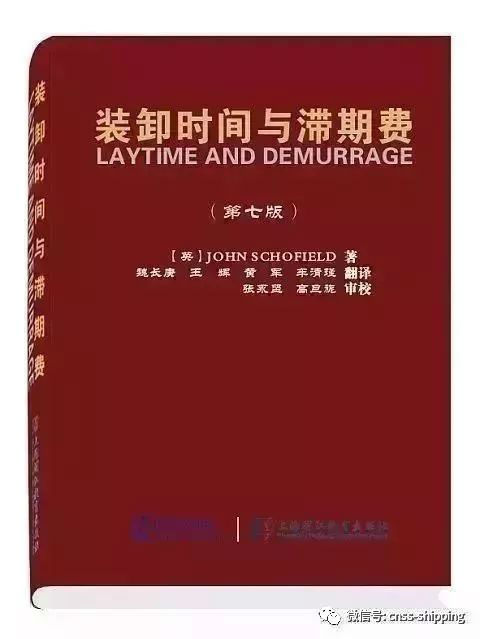Laytime Clauses 装卸时间条款
Working hours, working days of 24 hours, weather permitting
天气允许的工作时间,24个小时的工作日
2.112 It sometimes happens that the parties to a charterparty may wish to provide for allowed laytime in terms of a specified number of hours’ work. Where this is done, it is perhaps more common for it also to be expressed as a rate of work. Thus the full phrase might be:
. . . and discharge to be at the rate of 350 tons per working day of 24 hours, weather permitting.
For the purpose of this section, however, it is only the unit of time that will be considered. The rules relating to the phrase ‘‘weather permitting’’ have already been considered and similar principles will apply.
2.112有时,租船合同的当事双方可能希望将所允许的装卸时间规定为一定的工作时数。如果这样的话,也许更为通常的作法是表述为一定的作业率。这样,整个短语往往是:
……在天气允许的情况下,卸货率为每24个小时的工作日350 吨。
然而,为此我们这一节所要讨论的就是这一时间单位。有关‘天气允许’这一短语的原则我们已经讨论过,在此也同样适用。
2.113 As with other laytime clauses, the courts will look at all the relevant clauses of the charter before deciding what the parties intended. This may be why one of the three reported cases dealing specifically with this type of clause might be said to provide a somewhat different interpretation to the other two. However, where the courts do conclude that the parties did intend to provide for a specified period of work and expressed it in terms of ‘‘working days of 24 hours’’ then all that is needed is to convert this into working hours by multiplying the number of days so provided by 24. This will then give the total number of working hours to be allowed to the charterers.
2.113 如同其他装卸时间条款一样,法院在确定当事人意图之前往往要査阅租船合同中所有相关的条款。这或许是为什么特别针对这一类型条款的三个报道的案例,可以说是其中之一的解释与其他两个不同的原因。不过,一旦法庭断定当事双方确实是要以‘24个小时的工作日’的条文来规定列明工作时间的话,那么就需要按规定的天数乘以24得出的数转换为工作的小时数。这样就可得出给予承租人所允许的全部工作时数了。
2.114 Clearly, a ‘‘working hour’’ must be part of a working day. However, whether it is confined to those hours within normal working hours for the trade at the port in question or includes those hours on which overtime is usually worked is perhaps less clear.
2.114 显然,这一‘工作时间’必须是工作日的一部分。但是,在某个有争议的港口,对于某项贸易活动,这部分时间是否应限制在正常工作时间之内,还是包括也正常工作的加班时间,也许并不明确。

2.115 On balance it is submitted that those hours on which overtime is normally worked (whether or not actually used) should count and therefore similar principles will apply to those used in determining the length of the working day where laytime is expressed in terms of weather working days. However, if greater, the actual ‘‘working hours’’ used must count.
2.115 总的来说,可以认为,通常也进行作业的这部分加班时间(不论实际是否使用)就应该予以计入。因此,当装卸时间是以良好天气工作日表示时,类似原则亦可适用于判定工作日长度的那些时间。然而,如果能够进行工作的时间更长的话,则实际使用的‘工作小时’也必须计算。
2.116 If, therefore, a charter were to allow ‘‘two working days of 24 hours’’ and each working day was found to consist of 12 working hours, it would take four calendar days before the laytime was used up.
2.116 因此,如果租船合同允许的是‘两个24个小时的工作日’,而且每个工作日都被认定是由12个工作小时组成的话,则在装卸时间用尽以前,它可能占用四个日历日。
2.117 The leading case on this type of clause is Forest Steamship Co Ltd v. Iberian Iron Ore Co Ltd, a case which eventually reached the House of Lords.
2.117对这类条款的典型的案例是Forest Steamship Co Ltd v. Iberian Iron Ore Co Ltd一案,该案件最终一直打到上议院。
2.118 The facts were that the parties had agreed that the plaintiffs would supply ships for the carriage of iron ore from Seville to the United Kingdom and elsewhere over a period of 12 months. An ordinary single voyage charter was used, appropriately adapted. The material provisions of the charter were as follows:
Charterers... to be allowed 350 tons per working day of twenty-four hours weather permitting (Sundays and holidays excepted), for loading and discharging... Steamer to work at night if required, also on Sundays and holidays, such time not to count as laydays unless used...
2.118该案的案情是这样的:当事双方协议由原告提供船舶在12个月期间内从西班牙Seville往英国以及其他地方运输铁矿石,他们选用了一个普通的航次租船合同,并做了适当地修改。其中的重要条款如下:
允许承租人在天气允许的情况下,以每24个小时的工作日350吨的效率进行装卸货作业(星期日和节假日除外)……如果需要的话,船舶可在夜间也可在星期日和节假日进行装卸作业,但这些时间(除非使用)不计入装卸时间。

2.119 Rejecting an argument from the plaintiff shipowners that the charterers were only entitled to one working day for each 350 tons of ore, no matter of what number of hours such working day might happen to consist, Smith LJ said in the Court of Appeal:
. . . the plaintiffs’ contention appears to me to give the go-by to the words which presumably were inserted for some purpose in the charter—viz. ‘‘of twenty-four hours’’—and reads the charterparty as if those words were not there. Why were these words inserted? It seems to me for the express purpose of giving to the charterers a fixed period of twenty-four working hours wherein to load or unload each 350 tons of ore, no matter what number of hours might constitute a working day at the port of loading or the ports of discharge.
Later he added:
But a ‘‘working day of twenty-four hours’’ is not the same as ‘‘a working day’’ ...
He also found significant support for the defendant charterers’ argument in the ‘‘unless used’’ clause which as far as the working at night part was concerned would have been unnecessary if the shipowners were right.
2.119原告船东的争辩:不论这样一个工作日可能由多少个小时组成,承租人只有权在一个工作日内装/卸350吨铁矿石。上诉法院的Smith大法官否决这一观点,说:
……据我来看,原告所持的论点是想避开租船合同中估计可能是特别强调的字眼——即‘24个小时的’——而视该租船合同如同没有这个字眼一样。为什么要加进这些词语?对我来说好像明显的目的是给予承租人每装/卸350吨铁矿石一个固定24个小时的工作期间,而不论在装港或卸港的一个工作日到底由多少个小时组成。
后来他又补充到:
但,一个‘24个小时的工作日’与一个‘工作日’是不一样的……
他又认定条款中‘除非使用’一句对被告承租人以极大的支持,因为如果船东说得对的话,那么就夜间作业而论,这一词语就是多余的了。
2.120 On the other hand, in a dissenting judgment, Rigby LJ argued that the charterers’ view totally ignored the established meaning of ‘‘working day’’ by converting it into 24 working hours. The third judgment by Vaughan Williams LJ supported the charterers and thus, by a majority, the Court of Appeal held that the laytime clause meant that charterers were to be allowed 24 working hours for discharging each 350 tons.
2.120 另一方面,Rigby大法官却持不同看法,他坚持认为承租人的观点完全忽视了‘工作日’已有的基本含义,而将它转化为24小时了。Vaughan Williams大法官做出的第三个判决支持承租人,因此,根据少数服从多数的原则,上诉法院判定:这种装卸时间条款意思是,每卸350吨允许承租人使用24个工作小时。
2.121 This conclusion was upheld, although not without some doubt, by the House of Lords, where the only speech of any length was given by the Earl of Halsbury LC, who concluded that the parties intended to manufacture a conventional or artificial day out of a certain number of hours.
2.121尽管还有些争议,对于这一结论,上议院还是维持原判,这里只有上议院议长Halsbury伯爵给出判决意见,他总结说这是当事双方意欲发明创造一个由一定的时数组成的协议日或人为日。

《装卸时间与滞期费》购买链接(点击可购买)
海运圈聚焦专栏作者 魏长庚船长(微信号CaptWei)

 2018-05-02
2018-05-02 733
733 












